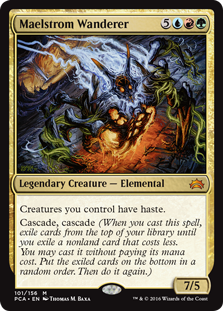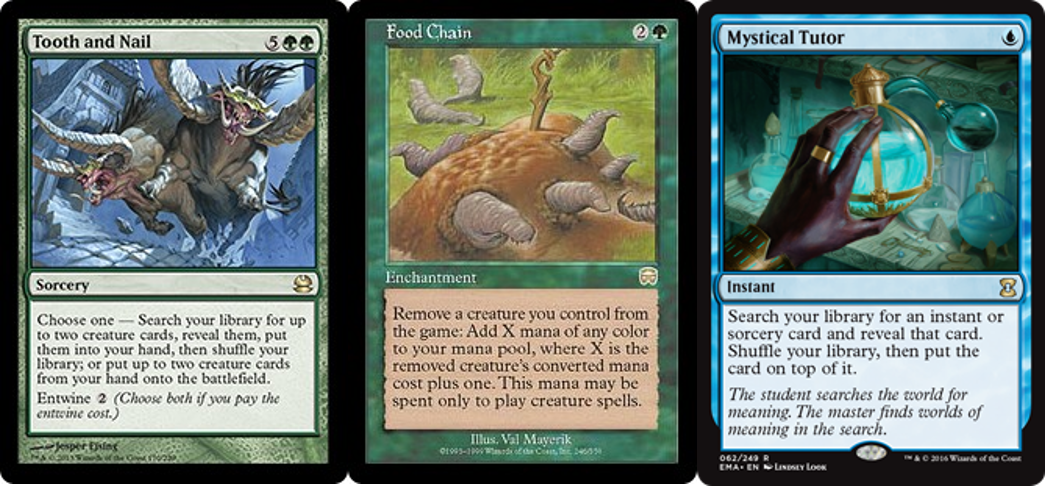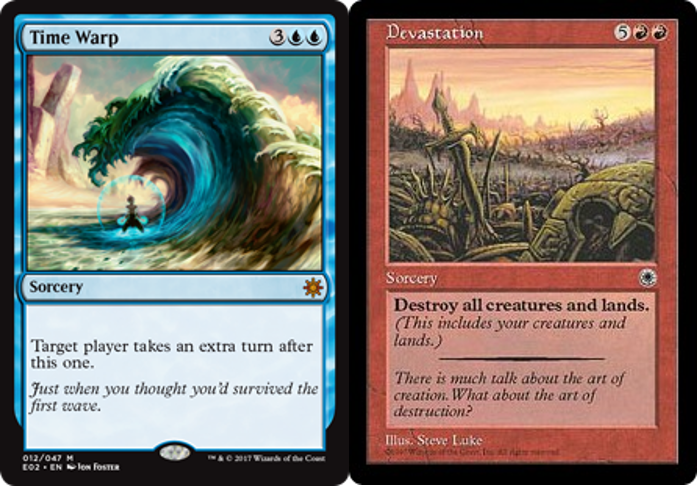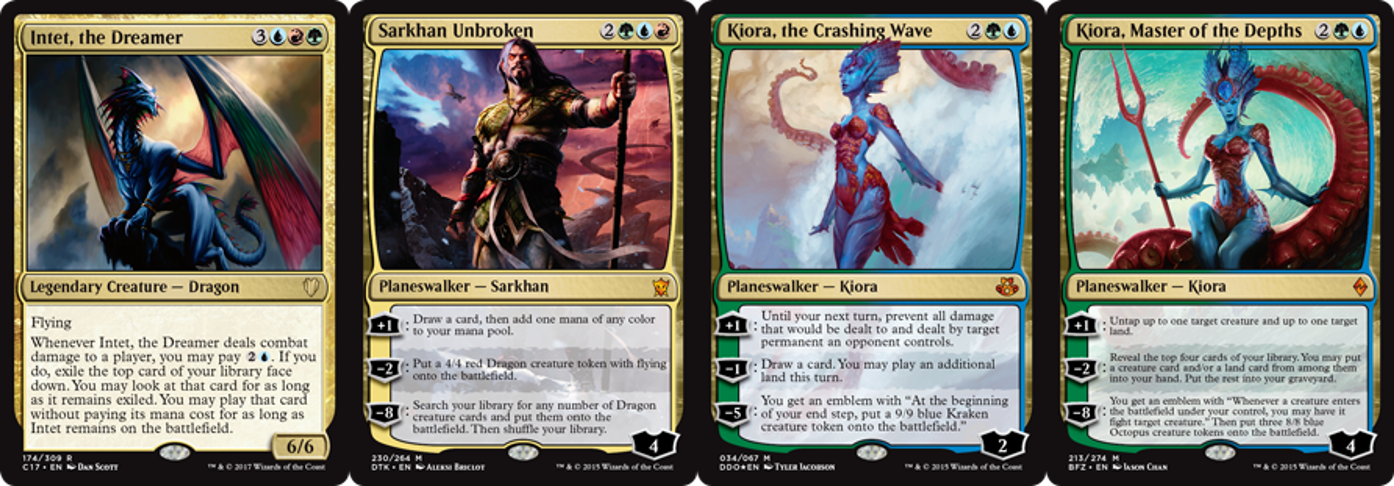The Knowledge Pool — Maelstrom Wanderer Part 1
Welcome back to The Knowledge Pool! During the last two installments I presented one of my longest tenured decks, Mayael the Anima. You can find my first article here, and part two here. I wanted to start this series with a deck I know inside and out so that I could best introduce the thought process I use when designing decks. This time, we're going to go in a slightly different direction: what happens when the deck you make doesn't turn out the way you imagine? I'm sure that most Commander players have had the experience of falling in love with a commander, carefully crafting a deck, amassing all the cards, and then the deck just doesn't perform how you hoped. Sometimes this happens because we've built our deck too hastily, but sometimes it turns out that the new commander we love operates differently than we predicted.
Mona Lisa Overdrive

This exact scenario has happened to me many times. I fell in love with the idea of Alesha, Who Smiles at Death, and I spent hours agonizing over all the correct pieces to include. When I finally played the deck, I discovered quickly that it didn't fit me. It wasn't that my deck was poorly made, but playing a deck centered on 2-power creatures wasn't exciting to me in practice. I found that when I first approach a deck I have a bad habit of focusing heavily on the best case scenarios the commander presents, and this was the case with Alesha. In my head, I was going to be building a mountain of value recurring my creatures with Reveillark, ramping ad nauseum with Burnished Hart, and tutoring for all my equipment with Stoneforge Mystic, but it never occurred to me that in most cases I would be lucky to get more than one successful recursion with Alesha's ability. What excited me was the unrealistic potential I had bestowed upon the deck, and when I realized most games involved me hard-casting weenies, the illusion was shattered.
I Wonder As I Wander...

In Commander deck building there is a clear disconnect between theory and operation, and a lot of the time it can be difficult to predict the latter. Maelstrom Wanderer was a deck I wanted to build for a long time, but I always found myself perplexed by the multitude of potential directions. I could build the deck focused on 6 and 7 cost spells in an attempt to get the most value from casting Wanderer, or I could focus on taking advantage of the fact that both cascade triggers resolve before Wanderer does, or I could try to take advantage of the fact that Wanderer grants haste to my creatures and play the biggest monsters in the Temur colors. In the end, I opted for an approach that borrowed from each of these directions. I wanted to maximize my value, and I wanted to have the chance to smash things, and I wanted to experiment with cards that are uniquely synergistic with these two categories.
Here's the deck I ultimately designed:

A quick look at this list reveals several key characteristics. The creature count is low. I wanted the deck to have several options to make use of Maelstrom Wanderer's Haste ability, mainly Scourge of the Throne, Balefire Dragon, and Pathbreaker Ibex, but in most cases I planned to win with Palinchron. Palinchron, much like Kiki Jiki is infamous in Commander for its ability to combo rather effortlessly with a wide range of cards. In this deck, Palinchron easily combos with Mana Reflection and Deadeye Navigator to produce infinite mana. Unlike most Palinchron focused decks, however, this deck did not have an obvious outlet for the infinite mana produced, and instead intended to invest the Palinchron mana towards recasting Wanderer or playing out the high cost spells in our hand. There are many arguments to be made as to why including Palinchron for was ill advised: other players knowing it was in my deck made me a bigger target, it didn't consistently ramp on its own, and cascading into it without premeditation made it vulnerable to removal. And, yet, stacking Palinchron on top of the deck with cards like Sensei's Divining Top, Scroll Rack, Brainstorm, or Worldly Tutor suddenly gave me the opportunity to more reliably reach one of my most desirable combos.

Combos were a theme of this deck. The ability to cast an entwined Tooth and Nail off of a cascade trigger was a shortcut to infinite mana, or loops to achieve infinite recursion. One of my favorite combos involved playing a Time Warp spell, cascading into a tutor (Mystical or Personal) for Seasons Past, and then looping Seasons Past and a Tutor for infinite turns. Finally, while not an infinite loop, Food Chain allowed us to cast Wanderer over and over often accruing enough value to end the game on the spot. The raw power of two cascade triggers was not lost on me as a deck builder, but I believed the chaotic nature of the ability would result in high variance, negating the linearity often associated with combos. This assumption wasn't wrong, but when combined with lots of top deck manipulation, I found that variance dwindled.
Infinite Hate

Another aspect of this deck that is worth noting is the inclusion of extra turn spells and land destruction spells. Most players have had an encounter with decks that take extra turns and decks that aim to destroy lands, but at the point of me designing my original Wanderer list, I hadn't. Anyone that's a part of the Commander community for a modest length of time discovers that these two strategies are generally reviled, and while I was aware of their reputation, I didn't believe including a bit of either in my Wanderer deck would be problematic. My logic was that I would likely take, at most, one or two extra turns a game, not regularly creating a state where I was the only player with turns. I also assumed that the chances of me destroying all the lands at the table off casting Wanderer was rather small, being limited to Devastation. And while I believe my logic was sound, operation deviated from theory.
The Unique Lightness of Ramp
I also want to address the deck's unique ramp package. In my Mayael series, I mention how I tend to focus on land based ramp for Green decks as I find it to be the most reliable option. While I stand by this opinion, each deck is unique in its requirements, and given the minor focus on land destruction in this deck, I elected to split my ramp between lands and artifacts. The inclusion of artifact ramp also had several other implications for card selection. For one, cards like Clever Impersonator and Phyrexian Metamorph now represented additional copies of Thran Dynamo and Gilded Lotus, in addition to all of the other creatures in the deck. Furthermore, I was able to include Tezzeret the Seeker in the deck as he represented a tutor for our artifact ramp, while being a source of ramp himself when we had mana rocks on board.
Another way Wanderer's ramp package deviates from the one I presented in my Mayael series is the additional card slots devoted towards ramp. In my Mayael series, I put a great emphasis on how the deck is designed such to take the greatest advantage of each stage of the game. I made a point of how I wanted to have early game defense and ramp, followed by mid-game utility, before finally ending with large creatures to end the game. Wanderer doesn't have the luxury of structuring its game plan in this way, as each early game and mid-game spell dilutes our potential cascade targets for Wanderer. With Mayael, the ability to see 5 cards means we can often filter out non-targets, but with Wanderer we're locked into whatever two cards we cascade into. With this consideration in mind, defensive cards are not a boon in a Wanderer deck. We won't be thrilled to cascade into Cultivate, but the additional lands will at least make our next turn more powerful. Cascading into Wall of Blossoms, conversely, would not be beneficial in any way at a late stage of the game. For this reason, I reallocated my early game presence exclusively towards ramp such that Wanderer is as easy as possible to cast quickly, while minimizing the dilution of my cascades.
Planeswalkin' Away

Finally, I want to address several cards that may appear out of place in this deck: the Planeswalkers. Commander players tend to have a somewhat negative opinion of Planeswalkers for a variety of reasons. In particular, the lack of impact that most walkers have on the board with respect to their casting cost is unappealing, and the fact that most walkers tend to have abilities that target single players or permanents is a disadvantage in a primarily multiplayer format. This is not to say that walkers are necessarily bad in Commander, as they tend to be fairly resilient to removal and many have potentially synergistic abilities. In the case of this deck, both the Kioras and Sarkhan were included in large part because they fit the color identity of Wanderer, despite the fact that they didn't necessarily fit the other themes of the design. In the few games that I managed to play I found that they weren't disappointing, albeit not exciting. I could easily see removing them as I aim for a more cohesive deck, however I don't believe they would be a detriment to any deck that includes them. Intet, the Dreamer is another card that I included primarily because I wanted the opportunity to play with her, and because she represented a second Temur legend in the deck that could act as a secondary commander. I feel many players would argue that cards like these are in the greatest spirit of the format, and I personally feel that commander gives us a unique experience to experiment with "pet-cards". While the primary focus of this series doesn't typically involve the use of pet-cards, I still encourage everyone to make room for cards they love - you will have a better experience if you do.
In the several dozen games I played with my Wanderer deck, the majority ended with me playing solitaire. I would ramp until I could cast Wanderer, and then I would cast Wanderer again, and again, and again. What I didn't account for was the deck's ability to replay Wanderer many times in the same turn and across multiple turns, as aside from Food Chain I hadn't designed the deck to do so. I found it incredible, however, just how easy it was to do, and it turned out that when I played Wanderer over and over, I would inevitably cascade into a spell that destroyed lands or took extra turns. With each extra turn, I cast Wanderer again, and hitting spells like Wildfire made the possibility of my opponents clawing back into the game an impossibility. Eventually the additional cascades would result in a lethal board-state involving creatures or one of the combos in the deck, and the game would end after several turns of me playing my deck.
The Fine Line Between Love and Hate
The deck was a blast to play, and as its pilot, watching the deck in operation was magnificent. However, the Commander experience as a whole was dreadful. My opponents were bored and frustrated, and unsurprisingly had no interest in playing against Wanderer again. And while I understand that my list isn't on the level of a competitive Commander deck, it faced little resistance from a field disinterested in games ending before turn 8.
I took a break from Wanderer for awhile, but my interest in redesigning the deck has always remained. Now that I know how good this deck can be, and I have a practical understanding of how this commander operates, I want to work towards a new design that removes itself from the elements that made the original so caustic. I plan to cut the land destruction, most if not all of the extra turn spells, and refocus away from combo related win conditions. The revised list should work towards a more engaging Commander experience, and I want to work with you all to come up with it.
I have several ideas that I think could act as a starting point for the new deck. Without land destruction effects, we can put a heavier focus on building up our lands, and given that we have access to blue card draw, we could potentially make the fullest use of cards like Exploration, Burgeoning, and Azusa, Lost but Seeking. This focus would also make cards like Boundless Realms, Omnath, Locus of Rage, and Zendikar Resurgent incredible cascade targets. In addition, we can try to maintain a heavy focus on Wanderer, but instead of relying on combos to generate the mana to recast him, we can aim for a more organic solution. Food Chain toes the line of being too combo focused, but cards like Crystal Shard and Temur Sabertooth could help us protect all of our creatures while giving us an outlet to gather cascade triggers. Finally, we can try to make the most of Wanderer's cascade triggers and haste ability by including more high cost creatures with activated abilities or attack triggers. Arcanis the Omnipotent falls nicely into this category, as do Inferno Titan, Frost Titan, and Steel Hellkite.
A Future So Bright...
Wanderer is a commander ripe with possibilities, and these ideas are just a starting point for where we might go. You all gave me some awesome suggestions for my Mayael deck, and I would ask you to take the time to give me suggestions for this deck. In the next article(s), I plan to dig deeper into the theory behind our Wanderer deck, and try to build the best deck we can while being more conscientious of Wanderer's potential potency. Until then, I wish you all the best, and happy brewing!
Your opinions are welcome. We love hearing what you think about Magic! We ask that you are always respectful when commenting. Please keep in mind how your comments could be interpreted by others. Personal attacks on our writers or other commenters will not be tolerated. Your comments may be removed if your language could be interpreted as aggressive or disrespectful. You may also be banned from writing further comments.
